Incidence and Risk Factors of Complication in Awake Craniotomy: A10-year Retrospective Study
Main Article Content
Abstract
Background: Awake craniotomies for eloquent area lesion
resection and deep brain stimulation (DBS) have become
trend toward increasingly. Awake test is a challenging task
to perform adequate anesthesia without causing a
problem.
Methods: All awake craniotomy records from 2006 to 2016
in Ramathibodi hospital were reviewed. The anesthetic
techniques were all asleep-awake-asleep techniques.
Patients were divided into 3 methods according to the
ventilation techniques. First method was assisted or
controlled ventilation method (AC) during first asleep
phase. Patients in second method were on spontaneous
ventilation method (SP) throughout the surgery. Last
method, using nasopharyngeal airway with connector to
inhalation anesthetic agents, created a continuous positive
airway pressure (CPAP) while spontaneous breathing. Our
study reviewed complications and risk factors associated
with complications.
Results: Sixty-six patients were reviewed. Twenty-five
cases from 30 cases (83.33%) in AC method found
complications, mostly in neurological problems. Nineteen
cases from 33 cases (57.57%) in SP method had
complications, mainly in respiratory events. The serious
respiratory-related problems including upper airway
obstruction, reintubation, venous air embolism were only
found in DBS from SP method. In CPAP method, all 3
cases had complications. The significant associations with
complications were patients with seizure (p=0.032),
smoking patients (p=0.048), using fentanyl 100
micrograms or more (p=0.008), AC method (p=0.028),
tumor removal operation (p=0.015). There were inversely
related with complications by using dexmedetomidine
(p=0.042), SP method (p=0.007) and DBS (p=0.014).
Conclusion: Complications in awake craniotomy were
massive. Anesthesiologists must be aware throughout the
procedures and avoid factors that associated with
perioperative complications.
Article Details
References
techniques in the surgical treatment of temporal lobe epilepsy.
Can J Neurol Sci 2000;27 Suppl 1:S55-63; discussion S92-6.
2. Emory L SA. Awake craniotomy, epilepsy, minimally invasive
and robotic surgery: awake craniotomy. In: Cottrell JE. PP,
editor. Cottrell and Young’s neuroanesthesia. Philadelphia:
Elsevier; 2016. p. 298-301.
3. Huncke K, Van de Wiele B, Fried I, Rubinstein EH. The
asleep-awake-asleep anesthetic technique for intraoperative
language mapping. Neurosurgery 1998;42(6):1312-6;
discussion 6-7.
4. Bilotta F, Rosa G. ‘Anesthesia’ for awake neurosurgery. Curr
Opin Anaesthesiol 2009;22(5):560-5.
5. Sarang A, Dinsmore J. Anaesthesia for awake craniotomyevolution
of a technique that facilitates awake neurological
testing. Br J Anaesth 2003;90(2):161-5.
6. Poon CC, Irwin MG. Anaesthesia for deep brain stimulation
and in patients with implanted neurostimulator devices. Br J
Anaesth 2009;103(2):152-65.
7. Chakrabarti R, Ghazanwy M, Tewari A. Anesthetic challenges
for deep brain stimulation: a systematic approach. N Am J
Med Sci 2014;6(8):359-69.
8. Yamamoto F, Kato R, Sato J, Nishino T. Anaesthesia for
awake craniotomy with non-invasive positive pressure
ventilation. Br J Anaesth 2003;90(3):382-5.
9. Piccioni F, Fanzio M. Management of anesthesia in awake
craniotomy. Minerva Anestesiol 2008;74(7-8):393-408.
10. Senel FC, Buchanan JM, Jr., Senel AC, Obeid G. Evaluation
of sedation failure in the outpatient oral and maxillofacial
surgery clinic. J Oral Maxillofac Surg 2007;65(4):645-50.
11. Stevanovic A, Rossaint R, Veldeman M, Bilotta F, Coburn M.
Anaesthesia Management for Awake Craniotomy: Systematic
Review and Meta-Analysis. PLoS One 2016;11(5):e0156448.
12. Manninen PH, Tan TK. Postoperative nausea and vomiting
after craniotomy for tumor surgery: a comparison between
awake craniotomy and general anesthesia. J Clin Anesth
2002;14(4):279-83.
13. Brown T, Shah AH, Bregy A, Shah NH, Thambuswamy M,
Barbarite E, et al. Awake craniotomy for brain tumor resection:
the rule rather than the exception? J Neurosurg Anesthesiol
2013;25(3):240-7.
14. Blanshard HJ, Chung F, Manninen PH, Taylor MD, Bernstein
M. Awake craniotomy for removal of intracranial tumor:
considerations for early discharge. Anesth Analg 2001;
92(1):89-94.


